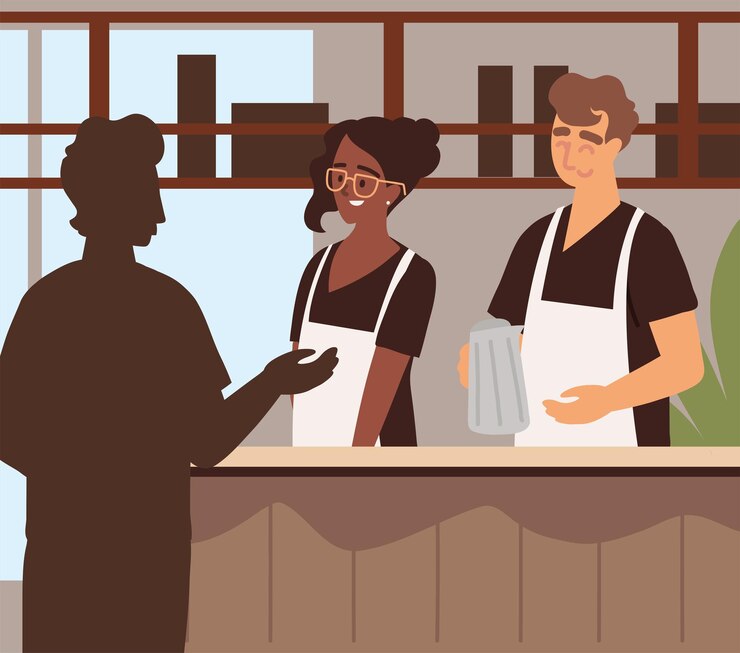Restaurant customer service standards include prompt greeting, polite interaction, and efficient service. Staff should be attentive and knowledgeable about the menu.
Great customer service in restaurants is crucial for creating a positive dining experience. Friendly, attentive, and knowledgeable staff can make a significant difference. Greeting customers warmly and promptly sets the tone for their visit. Staff should handle orders efficiently and address any issues swiftly.
Cleanliness and a well-maintained dining environment are also essential. Ensuring that all customer needs are met with a smile fosters loyalty and repeat business. Implementing these standards helps build a strong reputation and encourages positive reviews. Ultimately, excellent customer service is the key to a successful restaurant.
Greeting Guests
Greeting guests is crucial in restaurants. It sets the tone for the entire dining experience. A warm welcome can make guests feel valued and appreciated. Here are some examples and standards for greeting guests.
Warm Welcomes
A warm welcome should be sincere. Smiling is key. Use friendly words like “Welcome” or “Good Evening”. Ensure every guest feels special from the moment they enter.
- Smile genuinely.
- Make eye contact.
- Use friendly greetings.
First Impressions
First impressions matter a lot. The host or hostess should greet guests within 30 seconds. This shows efficiency and respect. It’s important to stand up straight and maintain a positive demeanor.
| Action | Standard |
|---|---|
| Greeting Time | Within 30 seconds |
| Body Language | Stand up straight |
| Voice Tone | Friendly and upbeat |
Taking Orders
Taking orders is a crucial part of restaurant service. It sets the tone for the entire dining experience. Ensuring that this process is smooth and efficient can make a big difference in customer satisfaction. Below are some key aspects to focus on when taking orders.
Attention To Detail
Attention to detail is essential when taking orders. Servers should listen carefully to the customer. They should repeat the order back to confirm accuracy. This step minimizes mistakes and ensures the correct dishes are served.
Servers should note any special requests or dietary restrictions. This shows the restaurant cares about each guest’s needs. It’s also important to write orders clearly to avoid kitchen confusion.
Here are some tips for attention to detail:
- Use a notepad or digital device to record orders.
- Ask clarifying questions if something is unclear.
- Ensure all modifications are communicated to the kitchen.
Suggestive Selling
Suggestive selling can enhance the customer experience. It involves recommending items that complement the customer’s order. For example, suggesting a wine that pairs well with their meal.
This technique can also boost sales. Servers can suggest appetizers, desserts, or special drinks. The key is to be genuine and not pushy.
Here are some examples of suggestive selling:
- Recommending the daily special or a popular dish.
- Suggesting a side dish that complements the main course.
- Offering a dessert menu after the main meal.
Training servers in suggestive selling can lead to higher customer satisfaction and increased revenue.
Serving Food
Serving food in a restaurant requires attention to detail and commitment. Excellent service ensures happy customers and repeat business. Below are crucial elements of serving food effectively.
Timely Delivery
Timely delivery of food is essential in a restaurant. Customers expect their meals to arrive promptly. Quick service shows respect for the customer’s time.
- Quick order processing: Ensure orders are processed swiftly to avoid delays.
- Efficient kitchen workflow: Streamline kitchen operations to speed up food preparation.
- Prompt serving: Servers should deliver food as soon as it’s ready.
Use a time-tracking system to monitor order times. Aim to serve within 15 minutes during peak hours.
Presentation Matters
Presentation of food affects the dining experience. A well-presented dish enhances the meal’s appeal.
- Garnishing: Add fresh herbs or edible flowers for a finishing touch.
- Clean plates: Ensure plates are spotless before serving.
- Consistent portions: Serve consistent portions to maintain quality.
| Aspect | Description |
|---|---|
| Garnishing | Add fresh herbs or edible flowers for a finishing touch. |
| Clean Plates | Ensure plates are spotless before serving. |
| Consistent Portions | Serve consistent portions to maintain quality. |
Proper presentation makes food look appetizing and professional. It shows the restaurant cares about its offerings.
Handling Complaints
Handling complaints in a restaurant is crucial. It can turn unhappy customers into loyal patrons. Here are some best practices to manage complaints effectively.
Listening Actively
Listening actively is the first step. Make eye contact with the customer. Nod to show you understand. Avoid interrupting them. Let them express their concerns fully.
- Make eye contact
- Nod to show understanding
- Do not interrupt
- Allow full expression
Take notes if needed. This shows you care. Repeat back what they said. This ensures accuracy and builds trust.
Problem Resolution
After listening, focus on problem resolution. Apologize sincerely. Express regret for the inconvenience. Offer a solution quickly.
- Apologize sincerely
- Express regret
- Offer a quick solution
Ensure the solution is practical. It should address the complaint directly. Follow up with the customer. Make sure they are satisfied.
| Steps | Details |
|---|---|
| 1. Apologize | Say sorry and mean it. |
| 2. Offer Solution | Provide a quick and practical fix. |
| 3. Follow Up | Check back to ensure satisfaction. |
By following these steps, you can turn a negative experience into a positive one.
Billing And Payments
Billing and payments are crucial aspects of restaurant customer service. They can significantly impact the overall dining experience. Ensuring smooth, accurate, and efficient billing processes helps build customer trust and satisfaction.
Accuracy
Accuracy in billing is essential for maintaining customer trust. Ensure all charges on the bill match the items ordered and served.
- Double-check each bill before presenting it to the customer.
- Use reliable billing software to minimize errors.
- Train staff to review orders and payments carefully.
Inaccurate billing can lead to customer complaints and loss of loyalty. Always prioritize accuracy.
Efficiency
Efficiency in billing speeds up the payment process and enhances the dining experience.
- Equip staff with portable card readers for quick payments at the table.
- Offer multiple payment options: cash, cards, and mobile payments.
- Implement a streamlined process for splitting bills among customers.
Efficient billing reduces wait times and keeps customers happy.
Farewell Protocol
A well-executed farewell can leave a lasting impression on guests. The farewell protocol is essential for ensuring that customers leave with a positive experience. Here we discuss some key elements to focus on during the farewell stage.
Gratitude Expressions
Expressing gratitude as customers leave is crucial. Use phrases like:
- “Thank you for dining with us.”
- “We appreciate your visit.”
- “It was our pleasure to serve you.”
Ensure the staff smiles and maintains eye contact. This makes the gratitude feel genuine. A simple, heartfelt thank you can boost customer satisfaction.
Invitation To Return
Encouraging guests to return is vital. Use inviting phrases such as:
- “We hope to see you again soon.”
- “Looking forward to your next visit.”
- “Don’t forget to try our specials next time.”
Offering a small incentive, like a discount coupon, can also encourage repeat visits. Make sure the invitation feels warm and sincere. This helps in building customer loyalty.
Employee Training
Effective employee training is crucial for enhancing restaurant customer service standards. It ensures staff are skilled, confident, and capable of delivering exceptional service. Proper training helps employees understand their roles and perform tasks efficiently.
Skill Development
Skill development is a key part of employee training. It focuses on improving specific abilities required for various roles in the restaurant. For example:
- Cooking skills for kitchen staff to prepare meals quickly and accurately.
- Communication skills for waitstaff to interact clearly with customers.
- Problem-solving skills for managers to handle any issues effectively.
Training sessions can include:
- Workshops and seminars.
- On-the-job training.
- Role-playing exercises.
- Online courses and tutorials.
A well-rounded training program boosts employee confidence and efficiency.
Customer Interaction
Proper customer interaction is vital for delivering excellent service. Employees must be trained to:
- Greet customers warmly as they enter the restaurant.
- Listen actively to understand customer needs and preferences.
- Address complaints promptly and professionally.
- Provide detailed information about the menu and specials.
Training should include:
| Training Component | Description |
|---|---|
| Role-playing | Simulate customer interactions to practice responses. |
| Feedback Sessions | Review performance and offer constructive criticism. |
| Interactive Workshops | Engage staff in group activities to improve communication. |
Effective customer interaction training improves overall customer satisfaction and loyalty.
Customer Feedback
Customer feedback is the backbone of any restaurant’s success. It helps you understand what your patrons love and where you need improvement. Gathering and acting on this feedback can significantly enhance the dining experience.
Collecting Reviews
Collecting reviews is essential for understanding your customer’s dining experience. Use multiple channels to gather these insights.
- Online Platforms: Encourage guests to leave reviews on Google, Yelp, and TripAdvisor.
- Social Media: Monitor comments and messages on Facebook, Instagram, and Twitter.
- In-Restaurant Surveys: Offer quick surveys on tablets or printed forms.
A mix of these channels ensures comprehensive feedback. Respond to reviews promptly. Address both positive and negative comments to show you value customer opinions.
Implementing Changes
Implementing changes based on feedback is crucial for growth. Start by categorizing feedback into actionable items.
| Feedback Type | Action Required |
|---|---|
| Food Quality | Adjust recipes, enhance flavors |
| Service Speed | Hire more staff, optimize kitchen workflow |
| Cleanliness | Increase cleaning frequency, train staff |
Prioritize changes that impact the customer experience most. Implement changes in phases and monitor their effectiveness. Communicate these improvements to your customers to build trust.
Regularly review the feedback loop to keep your standards high. This ensures your restaurant adapts and grows with your customers’ needs.
Frequently Asked Questions
What Are Key Restaurant Service Standards?
Key standards include prompt greetings, attentive service, clean facilities, and accurate order delivery.
How Can Staff Improve Customer Service?
Staff can improve by being friendly, attentive, and responsive to customer needs.
Why Is Greeting Customers Important?
Greeting customers warmly sets a positive tone and makes them feel welcome.
What Is The Role Of A Server?
A server’s role includes taking orders, serving food, and ensuring customer satisfaction.
How To Handle Customer Complaints?
Listen carefully, apologize sincerely, and resolve the issue promptly to ensure customer satisfaction.
Why Is Cleanliness Crucial In Restaurants?
Cleanliness ensures a safe dining environment and enhances the overall customer experience.
What Makes A Great Dining Experience?
Excellent service, delicious food, and a welcoming atmosphere create a memorable dining experience.
Conclusion
Excellent customer service elevates a restaurant’s reputation. Implement these standards to enhance guest experiences and encourage repeat visits. Consistent training and genuine care make a difference. Remember, happy customers become loyal patrons. Prioritize service excellence, and watch your restaurant thrive.
write more articles









